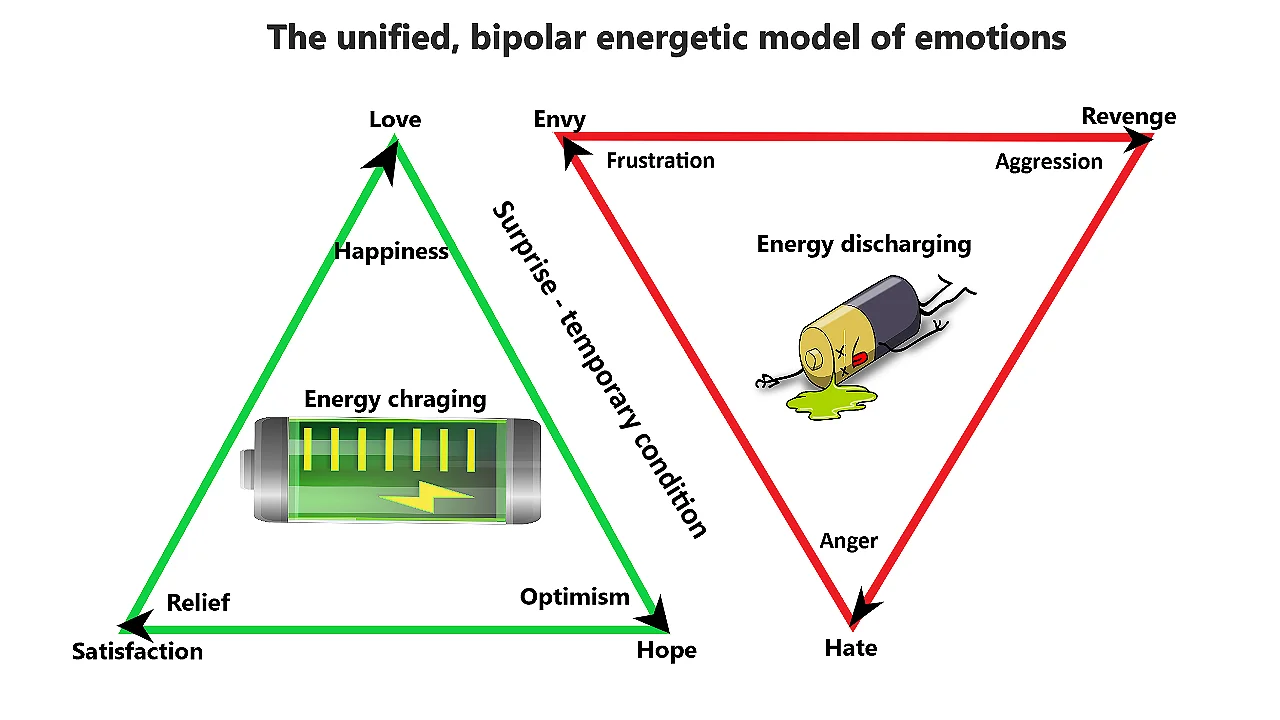
We are used to thinking of music in terms of frequency and energy, which can be represented in numbers. The same can be attributed to words, but paradoxically, it isn't easy to accept that emotions can be described as frequencies. Treating emotions as energy flow significantly changes how we view them. Love, Envy, Hate, and Revenge are needed in a competitive world. Continue reading The Unified energetic model of primary emotions.
The suggested unified energetic model of primary emotions.
Emotions are sometimes expressed in various chemicals, but they are, first and foremost, an energetic phenomenon. Treating emotions as energy significantly changes the way you look at them.
Principles of the model:
- Energy is always in motion between poles (from positive to negative) and is cyclical. Therefore, emotions are also bipolar.
- Bipolarity means that every emotion has action and response. (In the diagram, the action appears outside the triangle, while the reaction appears inside the triangle.)
- If you search, you will find about 150 adjectives for emotions, but most reflect synonyms.
Most researchers marked six main categories: anger, fear, joy, love, sadness, and surprise. (I believe fear is not a controlled emotion but an instinct. It exists in all of us to one degree or another.)
Every meaningful and prolonged human interaction places us in one of two cycles: (Indifference is usually a temporary state)
- Harmonic positive emotions charge the energy of life.
- Disharmonious emotions drain the energy of life.
A bipolar form of Action and Reaction characterizes all emotions.
- The explanation for this is that energy always moves between poles.
Surprise is usually an emotion that does not belong to one of the two cycles.
- We often can very quickly classify it into one of the two cycles. (positive or negative)
Unsurprisingly, there are more negative than positive emotions in regular use.
- Prominent Harmonic (Positive) emotions: Love, Hope, Satisfaction, Relief, Optimism, Happiness, Joy, Compassion, Pride, Affection, and Tenderness.
- Prominent Disharmonic (Negative) emotions: Hate, Envy, Revenge, Anger, Frustration, Aggression, Disgust, Depression, Dislike, Fury, Rage, Resentment, Disappointment, Humiliation, Insecurity, grief, Isolation, Shame, Guilt, Embarrassment, Hopelessness, Suffering,
Uninterrupted synchronized energy flow - Harmonic emotions. (Positive) Asynchronous energy flow - Disharmonic emotions. (Negative) | Inside the triangle's - reaction, outside - action.
Unresolved mental traumas (Negative emotions) are most often stored in the subconscious mind. There is constant energy damage if the subconscious cannot contain the repressed emotions. The person usually develops diseases (including mental illness) or addictions in such situations.
These four groups of primary emotions reflect intersecting energy cycles; they are not accidental—they serve the purpose of survival.
.webp)
Continue reading The Unified, Bipolar, Energetic Model of Primary Emotions.

